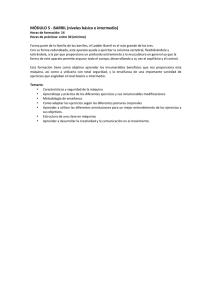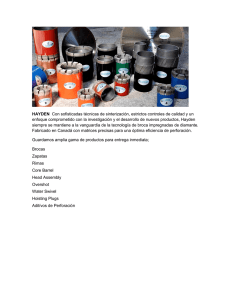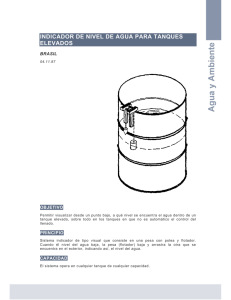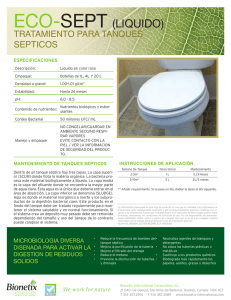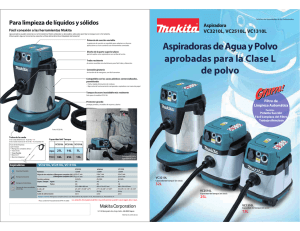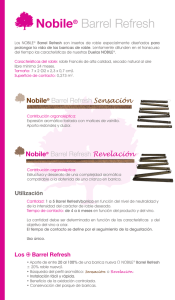RS-0001 V1.2 User Guide - Guía del usuario
Anuncio
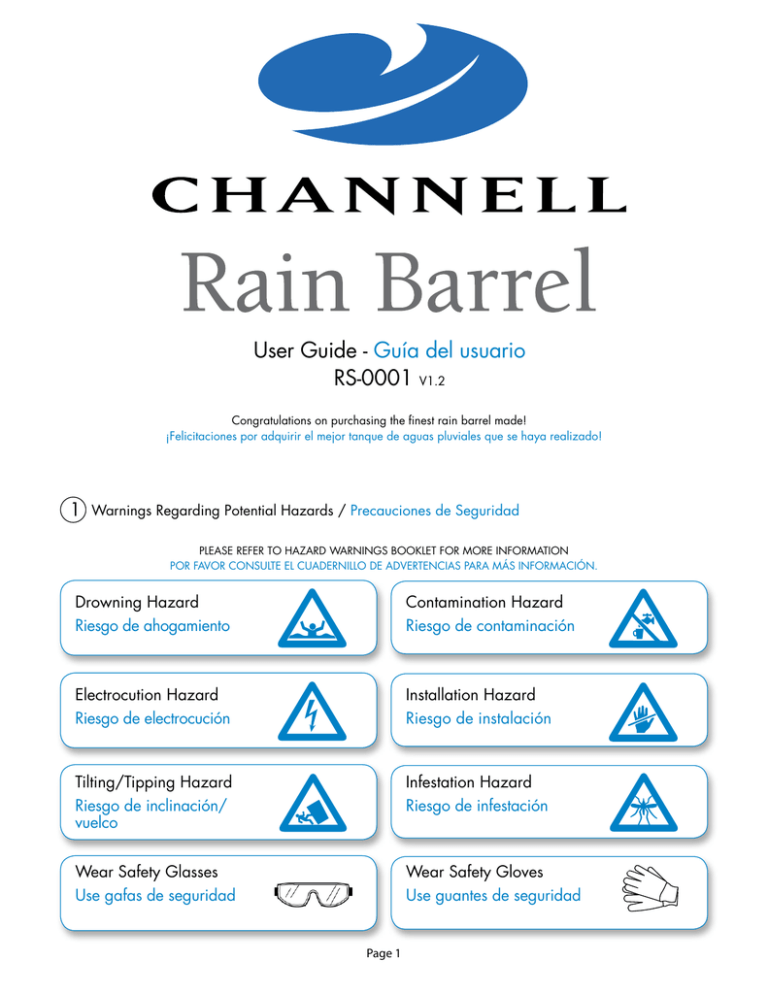
User Guide - Guía del usuario RS-0001 V1.2 Congratulations on purchasing the finest rain barrel made! ¡Felicitaciones por adquirir el mejor tanque de aguas pluviales que se haya realizado! 1 Warnings Regarding Potential Hazards / Precauciones de Seguridad PLEASE REFER TO HAZARD WARNINGS BOOKLET FOR MORE INFORMATION POR FAVOR CONSULTE EL CUADERNILLO DE ADVERTENCIAS PARA MÁS INFORMACIÓN. Drowning Hazard Riesgo de ahogamiento Contamination Hazard Riesgo de contaminación Electrocution Hazard Riesgo de electrocución Installation Hazard Riesgo de instalación Tilting/Tipping Hazard Riesgo de inclinación/ vuelco Infestation Hazard Riesgo de infestación Wear Safety Glasses Use gafas de seguridad Wear Safety Gloves Use guantes de seguridad Page 1 2 The Channell Rain Barrel is a state-of-the-art sealed rainwater collection system. With our patented Connection Kit Diverter, the Channell Rain Barrel is easy to install, clean, and winterize. Properly installed, it will provide years of trouble free use. 2 6 Please read all instructions and warnings before installation, and retain this brochure for future reference. 7 5 Channell Rain Barrel es un innovador sistema sellado de recolección de aguas pluviales. Con nuestro derivador patentado Connection Kit, el sistema Channell Rain Barrel es fácil de instalar, limpiar y aislar térmicamente. Si se instala correctamente, brindará años de uso sin problemas. Lea todas las instrucciones y advertencias antes de realizar la instalación y conserve este folleto para futuras referencias. 1 1. Barrel / Tanque 2. Lid / Tapa 3. Spigot / Grifo 3 4. Drain or hose attachment / Accesorio de ajuste para drenaje o manguera 5. Fill hose / Manguera de llenado 6. Connection Kit Diverter / Derivador Connection Kit 4 7. Winterization Hole Cover / Tapa del orificio de aislamiento térmico The Channell Rain Barrel barrel and lid are 100% recyclable. Made from approximately 30% recycled content. El tanque Channell Rain Barrel y la tapa son 100% reciclables y están realizados con 30% aproximadamente de material reciclado. 3 Some areas prohibit the use of rain barrels. Please check local regulations before installing. Algunas zonas prohíben el uso de tanques para aguas pluviales. Verifique las reglamentaciones locales antes de realizar la instalación. Contents / Contenidos 1. Barrel / Tanque 2. Lid / Tapa Tools Needed / Herramientas necesarias 1. Safety glasses / Gafas de seguridad 2 2. Safety gloves / Guantes de seguridad 2 3. Fill hose / Manguera de llenado 2 3. Phillips screwdriver / Destornillador de cruz Phillips 4. Water inlet (2) / Entrada de agua (2) 4. Pencil / Lápiz 5. Spigot and gasket / Grifo y junta 6. Drain plug, cap, and gasket / Tapón de drenaje, tapa y junta 5. Beam level / Nivelador 7. Connection Kit Diverter / Derivador Connection Kit 6. Work knife / Cuchilla de trabajo 8. Winterization hole cover / Tapa del orificio de aislamiento térmico 7. Measuring tape or ruler / Cinta métrica o regla 9. Hole Saw (2 1/8”) / Sierra cilíndrica (2 1/8”) 8. Drill / Taladro The cutting edge of the hole saw is sharp and presents a hazard. It must be used only as directed in this User Guide. 9. Solid surface base (optional) / Base sólida para superficie 10. Screws (3) / Tornillos (3) 11. User guide / Guía del usuario 12. / Librete de las advertencias del peligro Hazard Warnings Booklet 2 3 Do Not Discard Lid 4 7 5 8 6 9 1 Page 2 4 Assembling the Barrel Instalación del tanque 1. Instalación del drenaje inferior. 1. Install bottom drain. a. Inserte una pequeña junta dentro del orificio de drenaje ubicado cerca de la parte inferior del tanque. b. Enroque la tapa de drenaje en la salida de drenaje y asegúrese de que la tapa esté colocada en el lateral roscado más amplio. c. Enrosque el ensamble en la junta del orificio de drenaje, hasta que el collarín hexagonal quede ajustado contra la junta. a. Insert small gasket into drain hole near bottom of barrel. b. Thread drain cap onto the drain post, making sure the cap is on the largerthreaded side. c. Thread the assembly into the drain hole gasket until the hex collar is tight against the gasket. To prevent damage to the seal, do not over-tighten. Para evitar que el sello se dañe, no lo ajuste demasiado. 2. Install the spigot. 2. Instalación del grifo. a. Insert second small gasket into spigot hole at mid-height on the barrel. b. Thread spigot into the gasket until the spigot is tightened and positioned with the water outlet pointing down. a. Inserte la segunda junta pequeña dentro el orificio del grifo ubicado en el punto medio del tanque. b. Enrosque el grifo dentro de la junta hasta que quede ajustado y colocado con la salida de agua hacia abajo. 3. Install the water inlet. 3. Instalación de la entrada de agua. a. Insert the inlet into the fill hole below the rim on the backside of the barrel. b. Push the inlet in until it sits flat against the barrel. a. Inserte la entrada de agua dentro del orificio de llenado ubicado debajo del borde de la parte trasera del tanque. b. Empuje la entrada de agua hasta que se apoye bien contra el tanque. TIP Pinch the threaded rubber seal into a “C” shape before inserting into the hole in the barrel. TIP Soapy water or hand lotion on the hose cuff and rubber seal reduces friction and makes insertion easier. CONSEJO CONSEJO Agua enjabonada o crema de mano en el puño de la manguera y en el sello de hule reduce fricción y permite que la entrada sea más fácil. Apriete el sello roscado de hule en la forma de “C” antes de insertarlo en el agujero de barril. 5 Selecting and Preparing the Site Selección y preparación del lugar 1. The Channell Rain Barrel should be located close to a downspout, near the anticipated area of use on a solid and level service. a. If the spigot is used to distribute water, the area directly in front of the spigot should be easily accessible. b. If a garden hose or soaker hose is used to distribute water, the barrel and entire length of the hose path must be elevated above the area to be watered. 2. Place the barrel in the intended location and check to see that the fill hose can reach from the downspout to the water inlet on the barrel. 3. To make sure the surface beneath the barrel is level, set a beam level on the barrel rim to check. If using a garden hose, the barrel should be elevated for maximum water pressure. 2 1. El sistema Channell Rain Barrel debe estar ubicado cerca del bajante de aguas pluviales, cerca del área anticipada de uso en una superficie solida y nivelada. a. Si utiliza el grifo para distribuir agua, el área directamente del frente del grifo debe ser fácilmente accesible. b. Si utiliza una manguera para jardín o una manguera de irrigación para distribuir el agua, el tanque y la longitud total del recorrido de la manguera deben estar elevados por encima del área a regar. 2. Coloque el tanque en la ubicación prevista y revísela para ver que la manguera de llenado llegue desde el bajante hasta la entrada de agua del tanque. 3. Para asegurar de que la superficie debajo del tanque esté nivelada, coloque un nivelador sobre el borde del tanque para verificar. Si utiliza una manguera para jardín, el tanque debe estar elevado para una presión máxima de agua 2 3 Page 3 6 About the Connection Kit Diverter Acerca del derivador Connection Kit The Channell Rain Barrel uses a gravity fed Connection Kit Diverter to redirect water to the downspout when the barrel is full of rainwater. The diverter is inserted into a hole that is cut into the downspout. 1. The hole must be drilled at the correct height for the diverter to work properly. 2. If the hole is cut too low, the barrel will not fill. 3. If the hole is cut too high, water will overflow from the barrel rim. El sistema Channell Rain Barrel utiliza un derivador alimentado por gravedad Connection Kit para desviar el agua hacia el tubo bajante cuando el tanque se haya llenado de aguas pluviales. El derivador está insertado dentro del orificio que se corta en el bajante. 1. El orificio debe estar perforado a la altura correcta para que el deriva dor funcione adecuadamente. 2. Si el orificio está cortado a una altura demasiado baja, el taque no se llenará. 3. Si el orificio está cortado a una altura demasiado elevada, el agua se desbordará del tanque. Do not cut the downspout until reading instruction steps 7 and 8. Not for use with round downspouts. No corte el bajante hasta leer instrucciones pasos 7 y 8 1 2 If the hole is cut too low, the barrel will not fill. Si el orificio está cortado a una altura demasiado baja, el taque no se llenará. WARNING Damage to home or property may occur if improperly installed. ADVERTENCIA 3 Se pueden producir daños en el hogar o en la propiedad si la instalación se realiza incorrectamente. If the hole is cut too high, water will overflow from the barrel rim. Si el orificio está cortado a una altura demasiado elevada, el agua se desbordará del tanque. 7 Marking the Connection Kit Diverter Hole Marca del orificio del derivador Connection Kit 1. Mark a reference line even with the height of the barrel on the downspout using a pencil and a beam level, placed on the barrel rim as a guide. 1. Marque una línea de referencia aunque sea a la altura del tanque sobre la parte inferior del bajante con un lápiz y un nivelador, ubicado sobre el borde del tanque como guía. 2. Measure 2 inches (50mm) below the reference line and make another line on the downspout. Next make a mark on the lower line to show the center of the downspout. 2. Mida 2 pulgadas (50mm) por debajo de la línea de referencia y realice otra línea marque otra línea en el bajante. Luego, realice una marca sobre la línea inferior para mostrar el centro del bajante. Be sure to take any elevated base into account. 1 WARNING Asegúrese de tomar en cuenta cualquier base elevada. For 3x4” downspout, mark hole on narrow 3” side Para un drenaje del techo de 3x4”, marque el agujero en el lado más estrecho. 2 The barrel must be installed on a solid and level base. ADVERTENCIA El tanque debe estar instalado sobre una base nivelada y sólida. Page 4 8 Drilling the Connection Kit Diverter hole Perforación del orificio del derivador Connection Kit 1. Drill a hole in the downspout with a 2 1/8” hole saw. The center of the hole saw should align with center point marked on downspout. After drilling, carefully remove the hole saw to prevent the cut out piece from falling into the downspout 1. Perfore un orificio en el bajante con una sierra cilíndrica de 2 1/8”. El centro de la sierra cilíndrica debe estar alineado con el punto central marcado sobre el bajante. Luego de realizar la perforación, retire cuidadosamente la sierra cilíndrica para evitar que la pieza cortada se caiga dentro del bajante. a. Cuando realice el corte, no fuerce el taladro. Realice el corte en forma lenta y constante. b. Siempre utilice gafas de seguridad y guantes de seguridad cuando realice cortes y perforaciones. a. When cutting, do not force the drill. Cut slow and steady. b. Always use safety glasses and safety gloves when cutting or drilling. The cut edge of the downspout can be sharp. Wear protective safety gloves. El borde de corte del bajante puede ser filoso. Use guantes prot tores de seguridad. The cutting edge of the hole saw is sharp and presents a hazard. It must be used only as directed in this User Guide. For 3x4” downspout, drill hole on narrow 3” side Para un drenaje del techo de 3x4”, taladre el agujero en el lado más estrecho. WARNING ADVERTENCIA Installation Hazard Riesgo de instalación WARNING ADVERTENCIA Electrocution Hazard Riesgo de electrocución WARNING ADVERTENCIA Wear Safety Glasses Use gafas de seguridad WARNING ADVERTENCIA Wear Safety Gloves Use guantes de seguridad 9 Installing the Connection Kit Diverter Instalación del derivador Connection Kit 1. Connect filler hose to the FlexiFit Diverter before installing it into the downspout. Press the hose into the Diverter until the corrugated section is flush with the Diverter end. 1. Conecte la manguera llenadora al derivador FlexiFit antes de instalarlo al bajante. Presione la manguera dentro del derivador hasta que la sección corrugada esté alineada con el extremo del derivador. 2. Insert diverter into downspout hole by squeezing the sides, making sure the collection funnel faces up. Push in until the Diverter’s flange sits flat against the downspout. Check that the arrow on the outside of the Diverter is pointing straight up. 2. Inserte el derivador dentro del orificio del bajante y asegúrese de que el embudo de recolección esté hacia arriba. Empújelo hasta que la brida del derivador se apoye bien contra el bajante. Verifique que la flecha ubicada en la parte externa del derivador esté recta hacia arriba. 3. Use two of the self-tapping screws to attach the Diverter to the downspout. 3. Utilice 2 de los tornillos autorroscantes para ajustar el derivador al bajante. Diverter collection funnel must face up to work. For a 3x4” downspout refer to fig. A. For a 2x3” downspout refer to fig. B. WARNING El embudo de recolección del derivador debe estar hacia ar riba para que funcione. Para un drenaje del techo de 3x4” consultar a la fig. A. Para un drenaje del techo de 2x3” consultar a la fig. B. ADVERTENCIA Installation Hazard Riesgo de instalación WARNING 4” ADVERTENCIA 3"x 4" 2 A Electrocution Hazard Riesgo de electrocución 3” WARNING ADVERTENCIA 3 Wear Safety Glasses Use gafas de seguridad 2” WARNING 1 ADVERTENCIA 2"x 3" Wear Safety Gloves 3” Use guantes de seguridad TIP Soapy water or hand lotion on the hose cuff and rubber seal reduces friction and makes insertion easier. CONSEJO Agua enjabonada o crema de mano en el puño de la manguera y en el sello de hule reduce fricción y permite que la entrada sea más fácil. Page 5 B 10 Connecting the Barrel Conexión del tanque 1. Connect the other end of the fill hose to the water inlet on barrel. 1. Conecte el otro extremo de la manguera de llenado a la entrada de agua del tanque. 2. Press hose end firmly into the water inlet until it “bottoms out.” 2. Presione el extremo de la manguera dentro de la entrada de agua hasta que toque fondo. 3. The hose can be cut using scissors or a work knife, if a shorter length is required. 3. La maguera puede cortarse con tijeras o una cuchilla de trabajo, si se requiere una longitud más corta. a. The hose can only be cut in one foot increments, at the center of a flat section. a. La manguera únicamente puede cortarse en incrementos de un pie, en el centro de la sección plana. A sagging hose will collect water, which reduces filling efficiency. Una manguera suelta que recolecte agua reducirá la eficiencia de llenado. WARNING ADVERTENCIA Electrocution Hazard Riesgo de electrocución WARNING ADVERTENCIA Installation Hazard Riesgo de instalación WARNING ADVERTENCIA Wear Safety Gloves Use guantes de seguridad TIP Soapy water or hand lotion on the hose cuff and rubber seal reduces friction and makes insertion easier. CONSEJO Agua enjabonada o crema de mano en el puño de la manguera y en el sello de hule reduce fricción y permite que la entrada sea más fácil. 11 Covering and Locking the Lid Cómo tapar y bloquear la tapa 1. Place lid on the barrel, making sure the arrow on barrel rim is pointing to the Unlock icon on lid. 1. Coloque la tapa sobre el tanque y asegúrese de que la flecha ubicada en el borde del tanque apunte hacia el icono de desbloqueo de la tapa. 2. To lock lid, turn lid until arrow points to the Lock icon. 2. Para bloquear la tapa, gírela hasta que la flecha apunte hacia el icono de bloqueo. 3. To unlock lid, turn lid until arrow points to the Unlock icon. 4. A screw has been provided to prevent barrel from being unlocked. To use, turn lid to the locked position and center the screw on the dimple below the Lock icon. Carefully drive the screw through the rim of barrel and lid. The screw must be removed before twisting the lid to the Unlock position. 3. Para desbloquear la tapa, gírela hasta que la flecha apunte hacia el icono de desbloqueo. 4. Se ha proporcionado un tornillo para evitar que el tanque sea desbloqueado. Para utilizarlo, gire la tapa hacia la posición de bloqueo y centre el tornillo en la cavidad ubicada debajo del icono de bloqueo. Dirija cuidadosamente el tornillo a través del borde del tanque y de la tapa. WARNING ADVERTENCIA 1 Drowning Hazard Riesgo de ahogamiento WARNING ADVERTENCIA 3 2 Contamination Hazard Riesgo de contaminación WARNING 4 ADVERTENCIA Installation Hazard Riesgo de instalación WARNING ADVERTENCIA Lid must be locked at all times to prevent injury to children. La tapa debe de estar cerrada en todo momento para prevenir posibles daños a niños. Page 6 El tornillo debe ser retirado antes de girar la tapa hacia la posición de desbloqueo. 12 Using the Channell Rain Barrel / Cómo usar Channell Rain Barrel WARNING ADVERTENCIA WARNING ADVERTENCIA Contamination Hazard Riesgo de contaminación Rainwater is not suitable for human or animal consumption. Las aguas pluviales no son convenientes para el consumo humano o animal. There are several ways to access and distribute the water in the barrel. Use as much stored water as often as possible to make room for new rainwater. Existen varias maneras de acceder y distribuir el agua en el tanque. Utilice tanta agua almacenada como sea posible para hacerle lugar a las nuevas aguas pluviales 1. A Watering Can or Bucket can be filled by using the spigot. 1. Un bidón o balde con agua puede llenarse con el grifo 2. A Garden Hose can be connected to the spigot or bottom drain for watering remote areas. Note: To achieve gravity fed water flow, the barrel must be higher than the area to be watered. Elevating the rain barrel will improve water pressure. 2. Para áreas remotas de regado, puede conectarse una manguera para jardín al grifo o parte inferior de drenaje. Nota: Para alcanzar un flujo de agua alimentada por la gravedad, el tanque debe estar en una posición más elevada que el área a regar. Elevar el tanque de aguas pluviales mejorará la presión de agua 3. A Soaker Hose can be connected to the spigot or bottom drain. If connecting to bottom drain, an inline garden hose valve should be fitted in place of the drain cap. This will allow the water to be turned on/off as needed. 3. Una manguera de irrigación puede conectarse al grifo o parte inferior de drenaje. Si la conecta a la parte inferior de drenaje, la válvula de entrada de la manguera para jardín debe estar colocada en el lugar de la tapa de drenaje. Esto permitirá encender/ apagar la corriente de agua según sea necesario. 4. A Garden Hose Timer can be fitted between bottom drain and soaker hose to automatically dispense water at regular intervals. Be sure the timer is designed for low pressure applications. 4. Un temporizador de la manguera para jardín puede colocarse entre la parte inferior de drenaje y la manguera de irrigación para expender agua en forma automática durante intervalos regulares. Esté seguro que el medidor de tiempo este diseñado para aplicaciones de baja presión. 13 Always be sure to tighten spigot after use. Even a slow drip will empty the barrel over time. Siempre asegúrese de cerrar bien el grifo luego de utilizarlo. Aún un goteo lento vaciará el tanque con el tiempo. Linking Barrels (Optional) Unión de tanques (Opcional) RainStation barrels can be linked together to increase water storage capacity. Los tanques RainStation pueden ser conectados entre ellos para incrementar la capacidad de agua. 1. Drill a 1.5” diameter hole on the flat area beside the fill hole. Use the dimple molded on the flat area to center the drill bit. Insert the second water Inlet into the hole until the inlet rim sits flat against the barrel. 1. Taladre un agujero de 1.5” de diámetro en la parte plana junto al agujero de llenado. Use el agujero marcado en la parte plana para centrar la broca. 2. Insert the fill hose from the second barrel into the inlet on first barrel to link. 2. Inserte la segunda entrada de agua en el agujero hasta que el anillo de la entrada de agua se ajuste contra el tanque. Inserte la manguera de llenado del segundo tanque dentro de la entrada de agua del primer tanque para unir. WARNING ADVERTENCIA Installation Hazard Riesgo de instalación WARNING ADVERTENCIA Wear Safety Glasses Use gafas de seguridad WARNING ADVERTENCIA Wear Safety Gloves Use guantes de seguridad Page 7 14 Winterizing the Barrel Aislamiento térmico del tanque The barrel can be damaged if used in freezing temperatures. El tanque puede dañarse si es utilizado en temperaturas bajo cero. To Winterize: Para aislarlo térmicamente: 1. Disconnect Connection Kit Diverter by removing the 2 screws, squeezing the sides and pulling the diverter out of the downspout. 1. Desconecte el derivador Connection Kit al retirar los 2 tornillos, apriete los laterales y tire el derivador hacia afuera. 2. Completely drain barrel making sure the water is being drained away from buildings, foundations, walkways, etc. 2. Drene el tanque completamente y asegúrese de que el agua sea drenada de los edificios, cimientos, pasarelas, etc. 3. Plug the hole in the downspout with the winterization hole cover. 3. Conecte el orificio en el derivador con la tapa de aislamiento térmico del orificio. Before storing, clean debris or sediment in the bottom of the barrel, diverter, and fill hose. Reattach the cap to the drain plug once the barrel is empty. Antes de almacenarlo, limpie los desechos o sedimentos del fondo del tanque, del derivador y de la manguera de llenado. Vuelva a ajustar la tapa al conector de drenaje, una vez que el tanque esté vacío. Freezing water can damage rain barrel and void warranty. El agua congelada puede dañar el tanque de aguas pluviales y anular la garantía. 3 1 WARNING ADVERTENCIA Tilting/Tipping Hazard Riesgo de inlinación/vuelco 2 15 Troubleshooting Resolución de problemas The barrel does not fill with water after rainfall. El tanque no se llena con agua luego de llover. 1. Check the drain gutter for blockage at the downspout connection. 1. Verifique si el grifo de drenaje está bloqueado en la conexión del bajante. 2. Remove the Connection Kit Diverter and check that it and the hose are not blocked by leaves or debris. 2. Retire el derivador Connection Kit y verifique que él y la manguera no estén bloqueados por hojas o sedimentos. 3. Make sure Diverter is installed with collection funnel facing up. 3. Asegúrese de que el derivador esté instalado con el embudo de recolección hacia arriba. 4. Make sure the filler hose is not raised above the Diverter. 5. Make sure Diverter is installed at the right height. If it is below the level of the barrel fill inlet, the barrel will not fill efficiently. Drain barrel and lower the ground beneath it, so that the barrel sits at the correct height, according to instructions. 6. Check spigot and bottom drain to make sure water is not leaking. Even a slow leak will drain the barrel over time. The barrel overflows and water leaks out from the lid. 1. The barrel is too low. 4. Asegúrese de que la manguera llenadora no esté elevada sobre el derivador. 5. Asegúrese de que el derivador esté instalado a la altura correcta. Si está por debajo del nivel de la entrada de llenado del tanque, éste no se llenará en forma eficiente. Drene el tanque y descienda el suelo que se encuentra debajo para que el tanque se apoye a la altura correcta, según las instrucciones. 6. Verifique el grifo y la parte inferior de drenaje para asegurarse de que esté perdiendo agua. Aún una pérdida lenta drenará el tanque con el tiempo. El tanque se desborda y pierde agua por la tapa. To correct: drain barrel and construct a solid base to raise the barrel to the correct height, according to the instructions (See Panel 6). The fill hose can be replaced by a 1 1/4” bilge hose available at most home centers. 1. El tanque está demasiado bajo. Para corregirlo: Drene el tanque y construya una base sólida para elevarlo a la altura correcta, según las instrucciones (consulte Paso 6). La manguera de llenado puede reemplazarse por una manguera de desagote de 1 1/4” disponible en la mayoría de los centros de artículos para el hogar. WARNING WARNING ADVERTENCIA ADVERTENCIA Electrocution Hazard Riesgo de electrocución Riesgo de inlinación/vuelco Tilting/Tipping Hazard Page 8
